Fred M. Locke Markings
found on Porcelain Insulators
Go back to Main Page
Paul Greaves spent countless hours verifying the many different Fred Locke markings on porcelain insulators. Different fonts and sizes of letters and numbers were used. Evidently the 1 to 4 line marking stamp did not securely hold the individual letters and numbers and sometimes a few letters shifted. The marking device was flat and often it was struck on the curved part of the insulator, which makes a rather poor impression of the entire marking. Some markings in the list had to be verified by studying several specimens whose combined partial markings allowed for a complete marking. Verifying each individual period, comma, apostrophe and comparative letter/number sizes required careful observation of many different specimens.
If you have an insulator with one the unverified markings, please contact Paul Greaves so he can confirm the details of the marking.
Click
on this link to view a PDF of all of the Fred
Locke markings
found on porcelain insulators. You can get a free PDF viewer at
![]()
The following article was researched and written by Paul Greaves. He has seen and studied hundreds if not a few thousand Fred Locke specimens and fragments in order to draw his conclusions. This is a work in progress, but, I'm sure you will agree, his progress to date far surpasses any similar research.
∞ ∞ ∞ ∞ ∞ ∞ ∞ ∞ ∞ ∞ ∞ ∞ ∞ ∞ ∞ ∞ ∞ ∞ ∞ ∞ ∞ ∞ ∞ ∞ ∞
Evolution of Fred Locke Marking Stamps
Used on insulators in the years 1900 and 1901
By Paul Greaves
The inspiration for this study began with the discovery of a dump containing the remains of about 250 M-2795 and M-2796 “gutter top” insulators in the winter of 2003-2004. These insulators are known as “gutter tops” in the insulator collecting hobby, due to their rain gutter like trough around the upper edge of the top section, and spout at one side. Glass based units are identified as M-2795 in the hobby, while porcelain based units are M-2796. The dump was in Nicolaus, California, about a mile from the old Bay Counties Power Co.’s line from Colgate to San Francisco, which was built in the 1900-1901 time period. It is very probable that the insulators in this dump were the result of an upgrade to the line sometime around 1905 or so. At that time, the gutter tops would have been removed from service. Also found mixed in with the gutter tops were about 15 M-3725 Fred Locke three-part insulators probably dating from 1904, and maybe 8 or 10 larger 4-part M-4415 “ringed” Thomas multiparts. These were all the predominantly yellow glaze colors representative of Thomas production in the mid-1900 decade. At least one of the Thomas’s was cemented extremely off-kilter, and was probably the result of the insulator falling over while the cement was still soft. It is therefore surmised that the four-parts were probably all dumped because they were defective or damaged in some way. Indeed, the majority of the M-3725’s also seemed to be damaged before they were discarded, as evidenced by the incomplete collection of pieces found for each specimen. The few that seemed more complete were of very noticeably inferior porcelain, and were probably discarded for that reason.
The gutter-tops were known to have been salvaged for re-use during this period, and indeed have turned up on many other lines in northern California known to have been built as late as 1925. It is unclear whether all of the Nicolaus find were damaged before being discarded in the dump, as nearly all of them were broken up pretty badly. During the year or two following the dump dig, many of these specimens were painstakingly reconstructed by matching pieces together, assisted by the many variations in glaze colors and physical details. Many are indeed noticeably incomplete, either in the base section or the top section. A couple appear to have been mostly complete, but could have easily been cracked before being discarded and further broken up. All this seems to indicate that this dump probably contained insulators that were damaged or defective in some way, and not useful for salvage.
In any case, the assemblage of so many specimens allowed for a unique opportunity to study Fred Locke production during this time period, both for marking styles used and manufacturing techniques. Much supplemental work was done by field studies of various power lines that were the second and third generation sites for re-use of the insulators. One line in particular was of particular interest as the insulators were all discarded in place when the line was abandoned, and although they were largely broken up at the time, the pieces were all left behind either hidden near the pole sites or buried near the pole base. This one line added over 100 additional data points to the study. Other field studies along local power lines, along with solicitations to the insulator collecting community, has resulted in about 450 gutter top specimens being recorded. Other articles will be written from this data set, but this one will emphasize marking styles used on Fred Locke insulators during 1900 and 1901. It was during this time that Fred Locke stamped their insulators with the date of production, making reconstructing the exact time various markings were used easy to establish.In order to complement and supplement this data, the insulator collecting community was also asked to provide information on any Fred Locke insulators that had date-stamp markings in addition to the normal company name and patent dates stamp. In addition to the M-2795 and M-2796 gutter tops mentioned previously, Fred Locke was also making M-2335, M-2336, M-2842 (several variations), U-529A, U-669, U-675, U-925, U-939C, and U-955 during the time date markings were used.
Beginning with the gutter tops, the story seems to begin in the spring of 1900, with the first big orders for the then revolutionary two part “combination” insulators designed for high voltage power (Gish, “Fred Locke, a Biography” p.110). As documented there, it can be estimated that the first production insulators were made in the May 1900 time frame (p.120). They were marked as shown below:
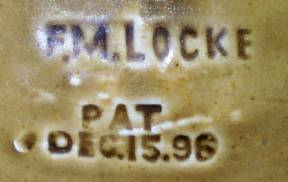

Front Back
These insulators have been found scattered along several lines along with the later production units, but since most of these lines used salvaged and recycled insulators, they are of little use for determining their original installation. The Nicholaus dump provided a unique opportunity to sample what was used along the Colgate line… and there were none of these early “303’s” found there. Field checking a few sections of the line up in the hills toward the powerhouse showed the same results. The other early line that used these insulators was the Standard Electric Company’s line from Electra to the south San Francisco Bay area. This line was actually started a bit earlier than the Colgate line, so it makes sense that it would use the first production (again, see Gish for more detail). Most of the line is difficult to field check, but a few sections were found that could be searched, and indeed fragments of 303’s were found there. It should be noted that every 303 I have seen (broken or whole) has a nearly identical dark yellowish tan color, as if they all came from the same production run. All the various non-303’s are of varying colors, but never quite this unique color. Soon afterwards, the “303” mark was dropped (indeed, the catalog number was changed to 316) and the marking was simply the name and patent date on one side, with Victor on the rear.

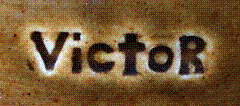
Front Back
As you can see, the style of the stamps are slightly different, which would seem to indicate that different marking devices were used. (The front marking is referred to as Fred Locke marking #1-5 in the various books written in the hobby.) One 303 has turned up with the Fred Locke name paired with the Victor mark, and the 303 paired with the patent date. This demonstrates that each line of the original marking was done with a separate stamping device. The following example, taken in the field, also seems to support this:

Apparently, soon after the 303 was dropped, the marking device was changed as shown previously. A very few specimens have turned up that have the same style marking as the 303’s, but no 303 mark; these were probably made just before the new stamping device was put into service (they are not the unique “303 color”). The new marking device apparently included both the Fred Locke name and the patent date, as all specimens are identical in letter positioning. Shortly thereafter, a second Victor marking was used as shown below (three variations are shown):



It should be noted that there are really only two main variations on the smaller VICTOR mark shown above… one has quotes around the VICTOR and one does not. (For some reason it is rare to find a good impression of the left quote.) It is not known if one was derived from the other, or if they were different devices. They are seen about equally commonly in the field. It is estimated that the small VICTOR marking was phased in about the same time as the large one, as the quantity of each type encountered in both the dump and in the field is nearly the same. These two stamp styles were used until sometime in the fall of 1900, when the 4- patent date markings began to be used. The first 4-date marking looked like this:


This is referred to in the hobby as the 4-1 marking. It was used with both the large and small Victor stamp on the rear, although the large VictoR marking is quite rarely encountered, and probably indicates that this marking was retired very soon after the 4-date marking was introduced. However, the 4-date marking is never seen paired with the small VICTOR in quotes. This may indicate that the marking with quotes was earlier, and indeed maybe the quotes wore off or were removed. This is perhaps supported by the fact that the vast majority of specimens are seen with only the trailing quote… as if the leading quote wore off first, or was damaged somehow. It is also interesting to note that the vast majority of specimens with this 4-date marking show no evidence of a period after the Y on the last line. In fact, the only specimen I have seen with it visible is the one with the large VictoR marking. The period must have fallen off very early in the stamps’ usage.
On (or close to) October 20 1900, the marking device was changed to include the manufacturing date below the VICTOR. One example is shown below:
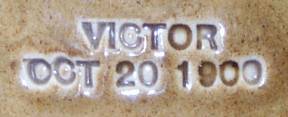
Another variation was also used with the date after the Victor (on the same line). The date stamps allow at least rough estimation of when the 4-date stamp was first used, based on the number of specimens found in the Nicolaus dump of each marking type. (The full data set is less useful, as I have not recorded all undated specimens seen in my field work.) 135 specimens were found with the 1-5 marking, and 13 of the 4-1 with just the Victor mark and no date mark. (Only one had the big VictoR.) If the first production was around May 1900 (let’s say late May to make it easy, since the 303’s would have been the first ones made in perhaps late April or early May 1900), and since the first dated specimen was late October, that means there was about 5 months of undated non-303 production. About 10% of them used the 4-date marking, so that would mean that the first 4-date marking was used for just over 2 weeks before Oct. 20, 1900. It would probably be a good estimate to say that they were all made in October of 1900.
On October 23, something interesting happened. The 4-1 marking stamp abruptly changes to the following variation (this particular specimen from Nov.14 1900):

Upon close examination, the end of the second line has changed. Instead of reading “JUNE 7’98” it now reads “JUNE,798”. But a careful examination shows that it is not really a comma, but rather an upside down apostrophe! It’s as if the stamp fell apart and was re-assembled haphazardly, with the apostrophe inserted in the wrong place and inverted. The “8” also looks like it may be inverted, and is lower than the previous numbers. This basic phenomenon of the stamps varying as if they were being re-assembled or repaired is something that will be seen again. I have seen specimens with the Oct. 23 date that have both versions of the stamp, so it was changed during production sometime on this day.
The 4-1 marking device continued to be used, and in December showed some peculiar problems with the last line. Several variations show the word “VICTOR” split as if some of the letters shifted vertically (not always in the same place). This seems to have been fixed without incident. By the end of March of 1901, the stamp looked like the next picture.
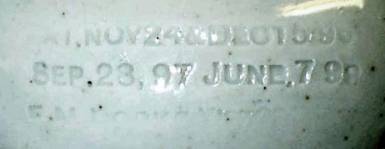
March 22 1901
The 98 at the end of the second line seems to have shifted to the right a little, leaving a space after the 7. Note the 8 is still shifted down a bit, and still appears to be inverted. The last line is showing some wear on the bottom of the letters (even on clear impressions).
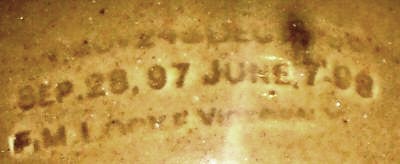
This example is from March 25 or 26 1901: (date unclear)
There seems to be a new apostrophe at the end of the second line, before “98”. It also seems that there is another mark in front of the “98”, perhaps a dash.
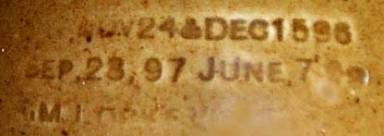
This example is from a specimen dated March 30 1901
Note the apostrophe near the end of the first line (before 96) has disappeared. The position of the 96 has slid to the left, compared to the line below. The period after “PAT” is still there.
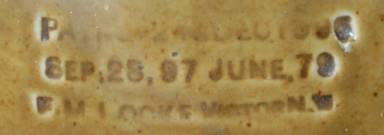
By May 2, 1901 the stamp looks like this.
The period after PAT has disappeared, and careful comparison to earlier markings shows that the “A” in PAT is slightly larger, and the PAT has been slid to the right to fill the space left by the missing period. This example also is lacking the 8 at the end of the second line; it is as if the 8 fell off. I suspect that these two things happened at different times, but we need more examples from the month of April to see if this is true. (The 8 had fallen off by April 4.) This marking is seen until May 4, 1901 (a Saturday). On May 6, the marking looks like this:
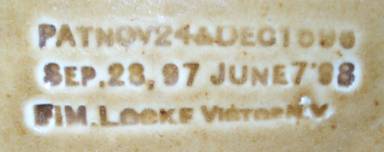
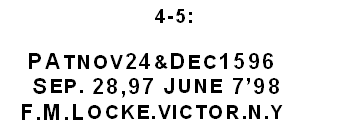
The 8 has been replaced, and in the process the upside down apostrophe has been moved back to its correct position. The 8 also looks correctly oriented. Otherwise, the marking looks the same as before. This exact stamp has been referred to as the 4-5 marking in the hobby. It has primarily been identified by the lack of any punctuation in the first line, but it should be apparent by now that the situation is really much more complex. The third line also shows the wear at the bottom, and no evidence of a period after the Y. I think this is still the same stamping device that made all the 4-1 markings… it is continually being repaired or altered. This version continues to be seen until at least June 14 1901. By June 19, 1901, the marking looks like this:

The 6 at the end of the first line has disappeared. This marking is seen until the end of July 1901 when all 4-date markings were retired (the latest seen is Saturday July 27 1901).
Meanwhile, another 4-date marking stamp was used as early as October 27, 1900… it is shown below:
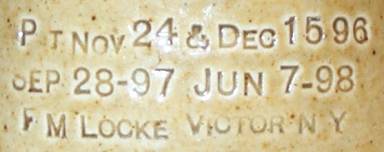
Another variation is missing the “A” in “PAT”.
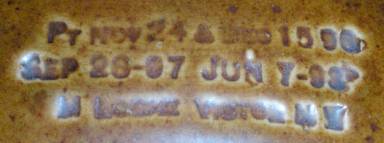
A third example is again different in the first line. This one is shown below:
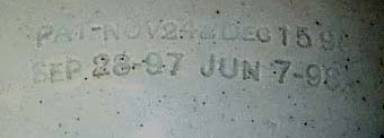
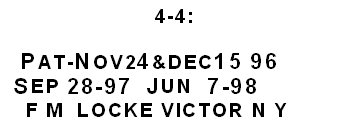
Note the addition of a “-“ after “PAT”, and the letter size of the “NOV” is bigger, and the first “2” is smaller. Unfortunately, the third line is nearly invisible on this specimen.
This is referred to as the 4-4 marking in the hobby. None of these examples exactly matches the reference books, but the third one is closest. The first example shown is dated Dec. 17, 1900 and the second is Dec.29, 1900. The third example is from Jan. 9, 1901. This marking seems to be scarce, with only 7 examples reported so far for this study. They are on an M-2795, an M-2335, two U-939C’s, and three U-675’s. The examples known are dated Oct. 27, 1900, Dec. 17 & 29 1900, and Jan 7, 9, 14, & 16, 1901. It is odd that most of them date from mid December 1900 to mid-January 1901, but one is from Late October 1900. It is also interesting that all three shown are different in some way. Perhaps more will be reported, that may shed more light on its use.
In December of 1900, another marking type shows up:
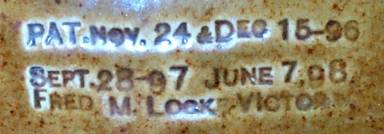

Another variation:
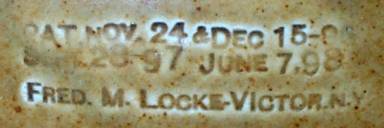
This is marking 4-2 as known in the hobby. This marking has only been seen in specimens made from Dec. 4 to Dec. 22 of 1900 so far. Note the considerable variation in the second line position… and variations in letter positions in the first line. It is as if the letters were free to drift around considerably. It is possible that this stamp did not work well, and was seldom used. It has only been reported on two M-2795 specimens, a U-955 and two U-939C’s.
Another 4-date marking shows up by May 13 1901. It is shown below:

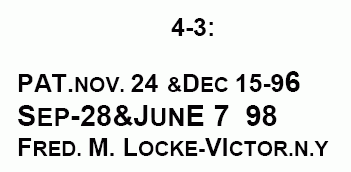
This is marking 4-3 as known in the hobby. It has some strong similarities to marking 4-2 shown previously. In particular, the top and bottom lines look identical. The middle line is quite different, changing as follows:

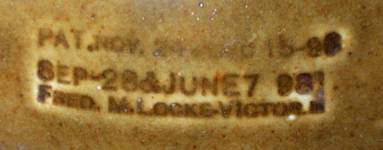
The Y at the end of the third line has vanished! I have seen several of these (all from June 13), so it is not a poor impression. (It is interesting to note that an example dated June 12 has been seen that has the “Y” strangely raised up and moved to the right.) By June 17 (Monday), the stamp was repaired, with substantial changes made to the third line:
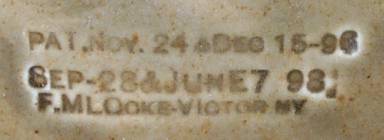
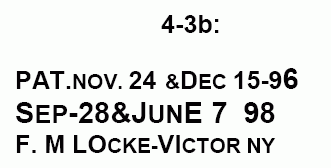
Note that it is in all other respects the same, including the funny marks to the right of the 8 at the end of the second line. This is marking 4-3b as known in the hobby. This stamp is seen until at least July 3 1901, which is the last example recorded in this series.
An interesting stamp occasionally shows up in mid-July 1901 as shown below:

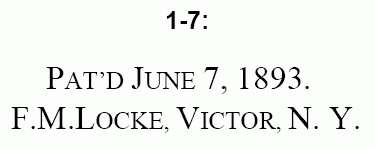
This stamp is known as the 1-7 marking in the hobby. It is also seen on earlier Fred Locke insulators, but was apparently retired from service sometime in 1900. I think the 4-3 marking device was lost or fell apart sometime after June 25, and the older 1-7 marking device was pressed into service for making M-2795’s. It has only been seen on a few specimens made from July 19 to July 23 so far. By August 1 the six date marking device was used exclusively.
I suspect that what we are seeing is evidence of two crews of workers. One crew used the 4-1 (and 4-5) marking device, while the other used the 4-2 and 4-3 (two variations) and later the 1-7 marking device. The dates of use of the two marking “families” overlap on numerous occasions, indeed the same dates are sometimes seen with both markings types. Within each marking family, the variations never overlap, and are as dated above. We may also be seeing evidence of the two crews with the earlier 1-5 marking as indicated by the little VICTOR and the big VictoR marks. It is hard to be certain of this however… it could also be that they had two guys stamping insulators at the same time just to make the job easier or faster.
On Aug 1 1901, the following six date stamp shows up:
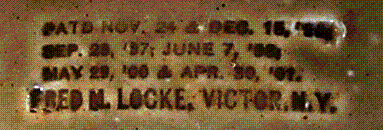

This is known as the 6-2 marking in the hobby. This mark is seen on specimens in the field dated from August 1 1901 to Dec 9 1901. Also, some factory dump specimens have been seen dated as late as Dec 29 1901. The factory burned on Jan.5, 1902 and production after that date never used the manufacturing date stamps again. All new company name & patent date markings were used from that time forward, as the older marking devices were presumably destroyed in the fire.
It should be briefly mentioned that occasional marking oddities have shown up. For example, one M-2795 has the small VICTOR mark on both sides, and no Fred Locke marking. Another has the 1-5 mark on one side, but nothing on the other. A very few have even shown up with no markings at all! And it is sometimes seen that the markings are stamped upside-down, or double stamped.
A bit of an addition is appropriate concerning the manufacturing date markings… as stated before they start on Oct. 20 1900, with the two-line date marking with VICTOR over the date (shown previously). On Nov.1 1900, a new variation begins to be seen that is all on one line:

This is seen occasionally, and always with the year abbreviated, until Dec. 17 1900. On Dec. 29 1900, a single line stamp is seen that includes the entire year, and this is seen until the end of production in Dec. 1901. The abbreviated year is never seen again. The two line stamp continues to be used until August 2 1901, which is the last date reported with it. By Oct.26 1901 a new variation is seen, that is identical to the single line stamp, but with the addition of a “1” before the VICTOR. This is seen mixed with the non-1 version, even on the same dates, until the end of production in December 1901. Again, I think we may be seeing evidence of two production crews, or at least two stampers at work. Here are examples of the two versions of the single line stamp, with full year:


It is interesting that sometimes the date shows up, but with no evidence of the VICTOR being apparent. With one exception this has only been seen on the smaller insulators. It sometimes may just be an example of the curvature of the skirt being such that the top line of the two-line stamp did not imprint. A few of these date-only markings have turned up with a very clear impression though, so it appears that sometimes they really did use a stamp that contained only the date. This has been seen from Dec.22 1900 to June 27 1901.
A few odd variations have also shown up, showing mistakes in lettering. This further proves that the stamps were capable of being re-arranged at will, with each letter being independently movable. A few examples follow:
OCT 81 00
JAN.7 8901
VICTOR SEPT 12 9101
MAY 14 1901 (the 4 is sideways)

.V1CTOR DEc9 (note, no year). No year is also seen on Nov 29, Dec 4, 7, 21, and 28.

And my favorite…

E is backwards, S is upside down, and last 1 is upside down!
There are a few other interesting things that can be learned by recording the dates and markings combined with the style they are seen on. For one thing, they seem to have regularly worked six day work weeks, and never on Sundays until late 1901 when a few Sunday dates showed up. Or, at least they were not stamping insulators (there would normally be someone tending the kilns when they were firing). It is also possible that those dates are errors. They worked Christmas eve, but not Christmas or New Years day (at least those dates have not been seen yet).
The date stamps also allow determination of what kinds of bases were used on the gutter tops. Up to Nov.26 1900, unmarked glass bases are seen exclusively. The first marked glass base is seen on a Nov. 27 1900 specimen, and the unmarked bases seem to have largely phased out by mid-December. A few odd examples from 1901 have turned up with unmarked bases, but could have been assembled from old stock bases. (These are of original construction, and have not been repaired by collectors.) I suspect that the order to mark the molds with the two patent dates occurred about the same time that the first 4-patent date markings were created (late October 1900). It probably took until late November for the first marked bases to be delivered and then actually get cemented to porcelain tops. The first porcelain base shows up in May of 1901, with both glass and porcelain base types being seen until the end of production in December.
Sulfur cement was used exclusively with the glass bases throughout production. Later production units commonly have a large percentage of sand mixed in, perhaps they used sand to position the base before pouring in the sulfur. It is also common for mid-production units to have an air bubble directly under the base, as if the sulfur was poured in after the base was positioned. Earlier production units seem to have sulfur under the base, as if the sulfur was poured in and then the base was plunged into place. A few porcelain units have turned up with original Portland cement instead of sulfur. They have only been seen on second or third generation lines, and may represent later use of older stock parts, assembled after the use of sulfur fell out of favor.
It is interesting to note that M-2795 production was very consistent and regular from Oct. 20 through Dec 29, 1900. (The factory was probably kept very busy fulfilling the orders for them during that first year.) This is also the time that very few smaller insulators have been reported. From January to early April 1901, no M-2795s or M-2796s have been reported. Smaller insulators are relatively abundant, for example U-675 production dates are common in the first two weeks of January, and U-925 is predominant at the end of March. A few others are scattered around this time, but it is interesting that so far, only one specimen has been reported between Jan. 16 and Mar. 21 of 1901. Either the production line was mostly shut down or perhaps the insulators from that time period simply never survived! It would make sense if many were used in places that have had a very low chance of survival, or perhaps they were shipped overseas, and remain to be discovered.
This pattern of M-2795 and M-2796 production alternating with smaller insulators, along with a few mysterious gaps (all shorter) continues throughout 1901. It is possible that some of the gaps are due to the workers changing their focus from pressing and making insulators (and stamping them) to glazing, loading, and unloading the kilns, and perhaps packing the finished ware. I think that with enough data gathering and reporting from collectors in the hobby, an even more complete and interesting record of the factory’s operation can be reconstructed.
Paul Greaves 6-22-09